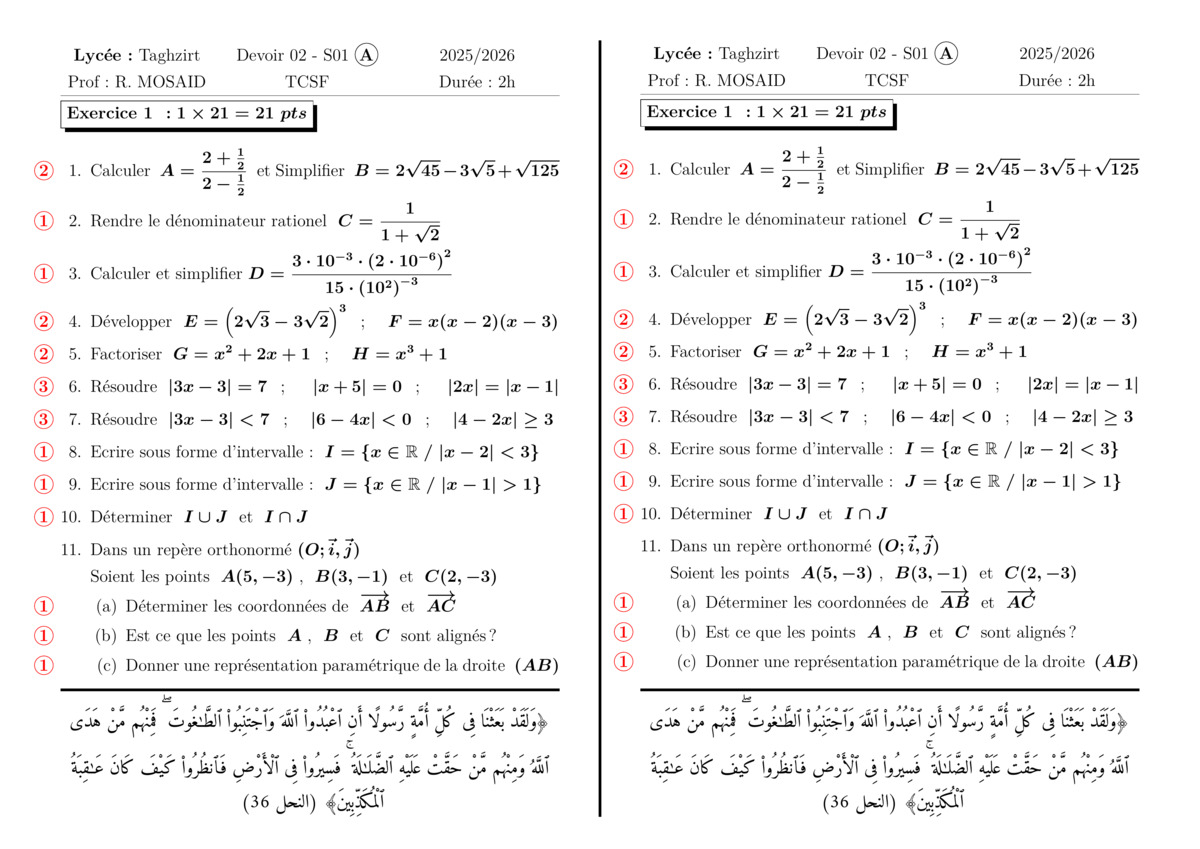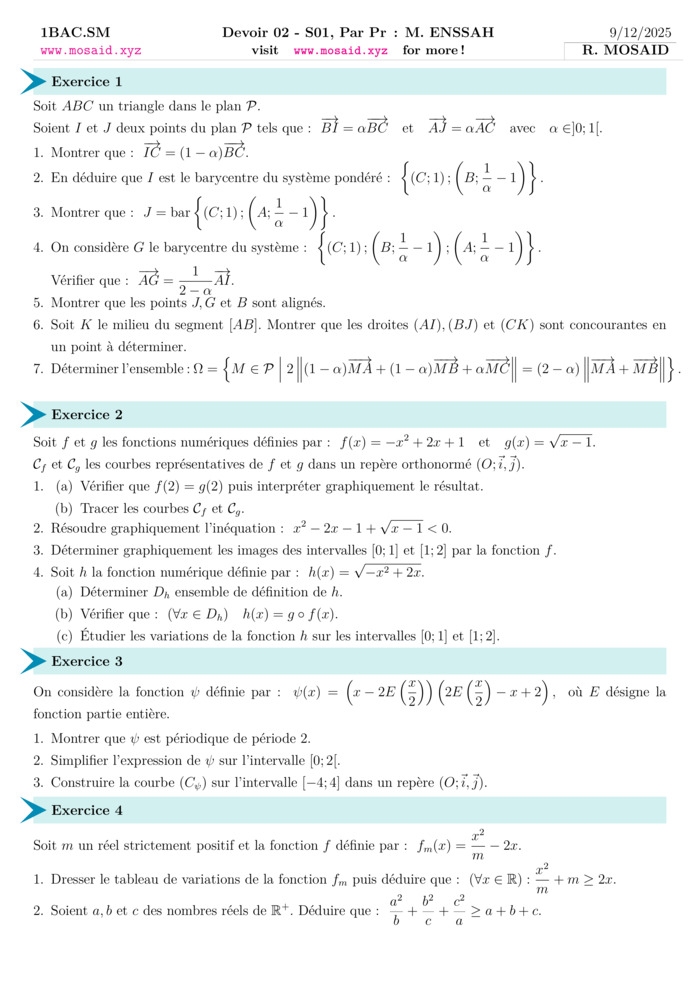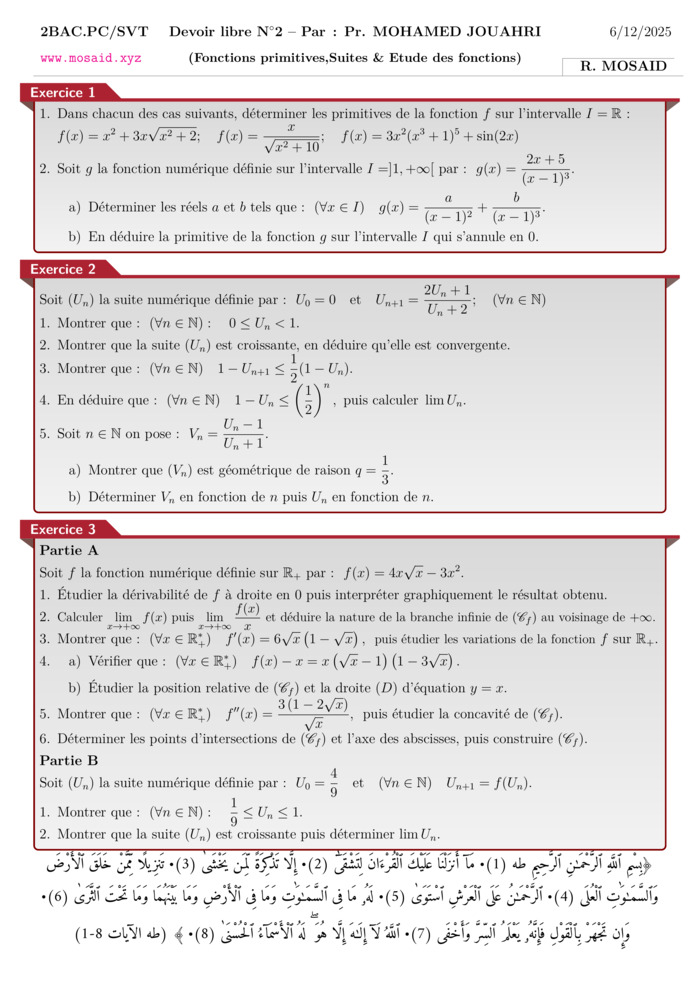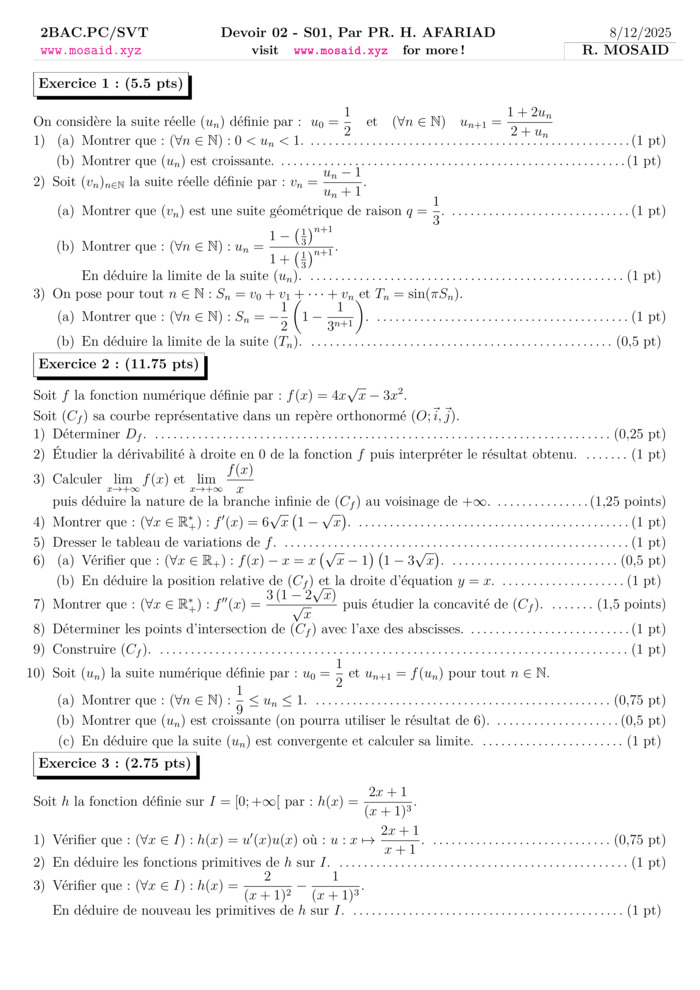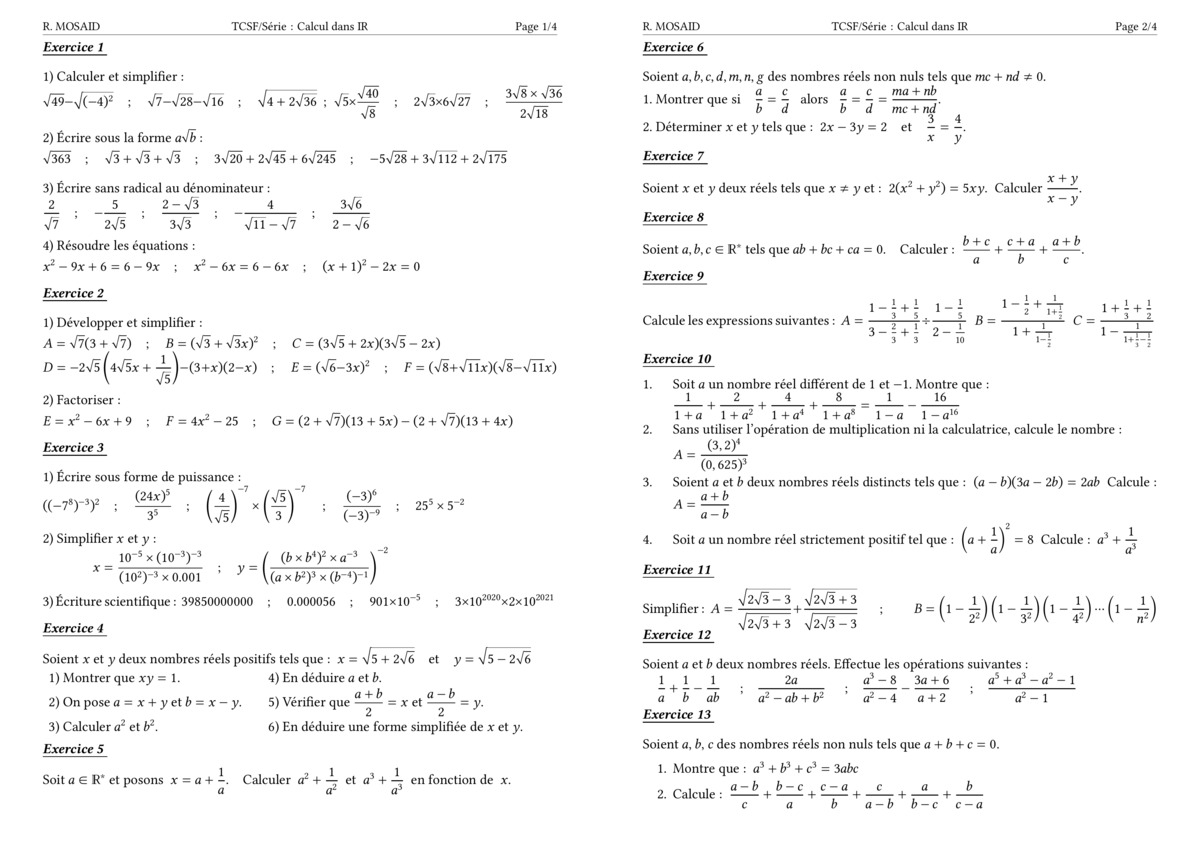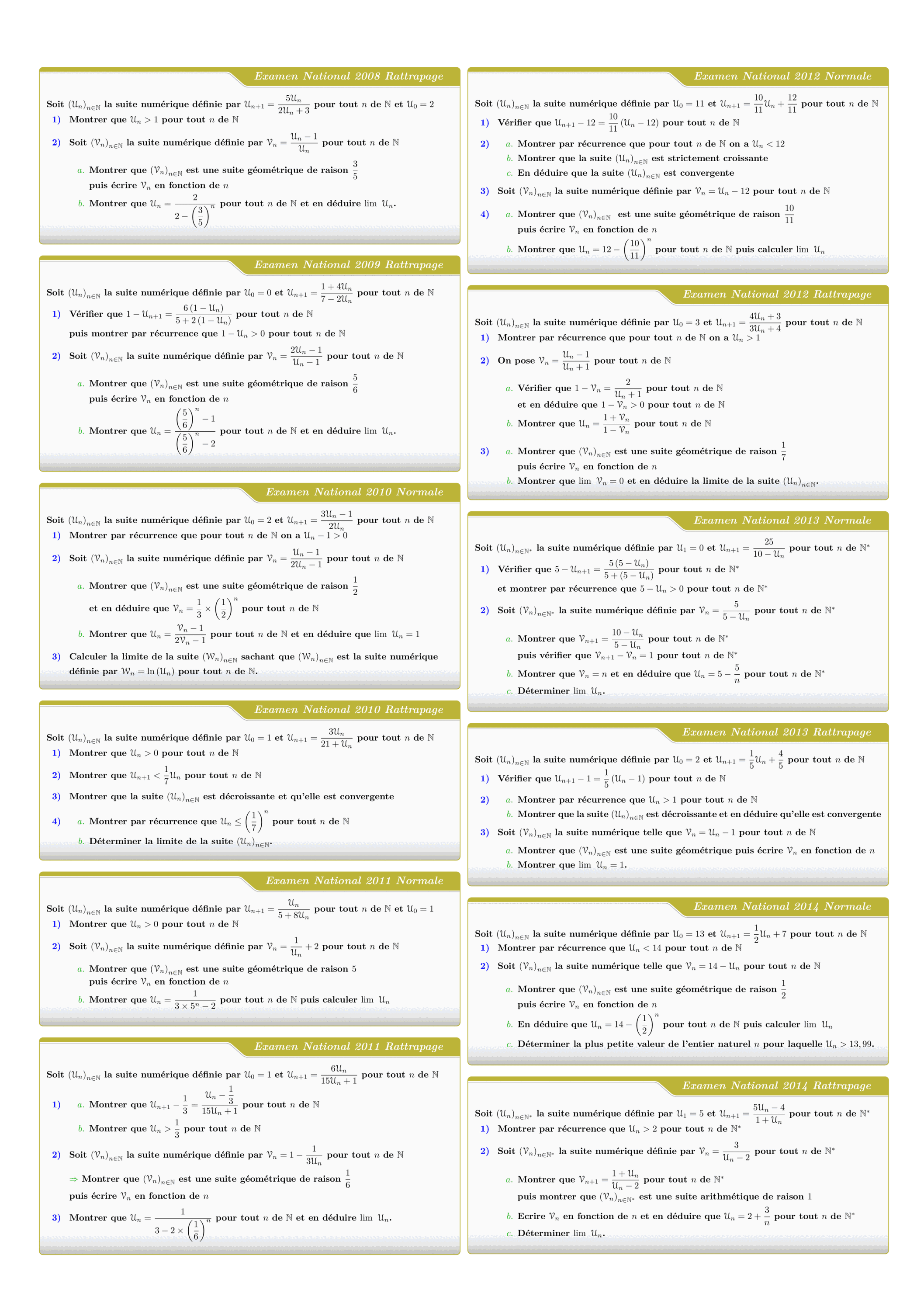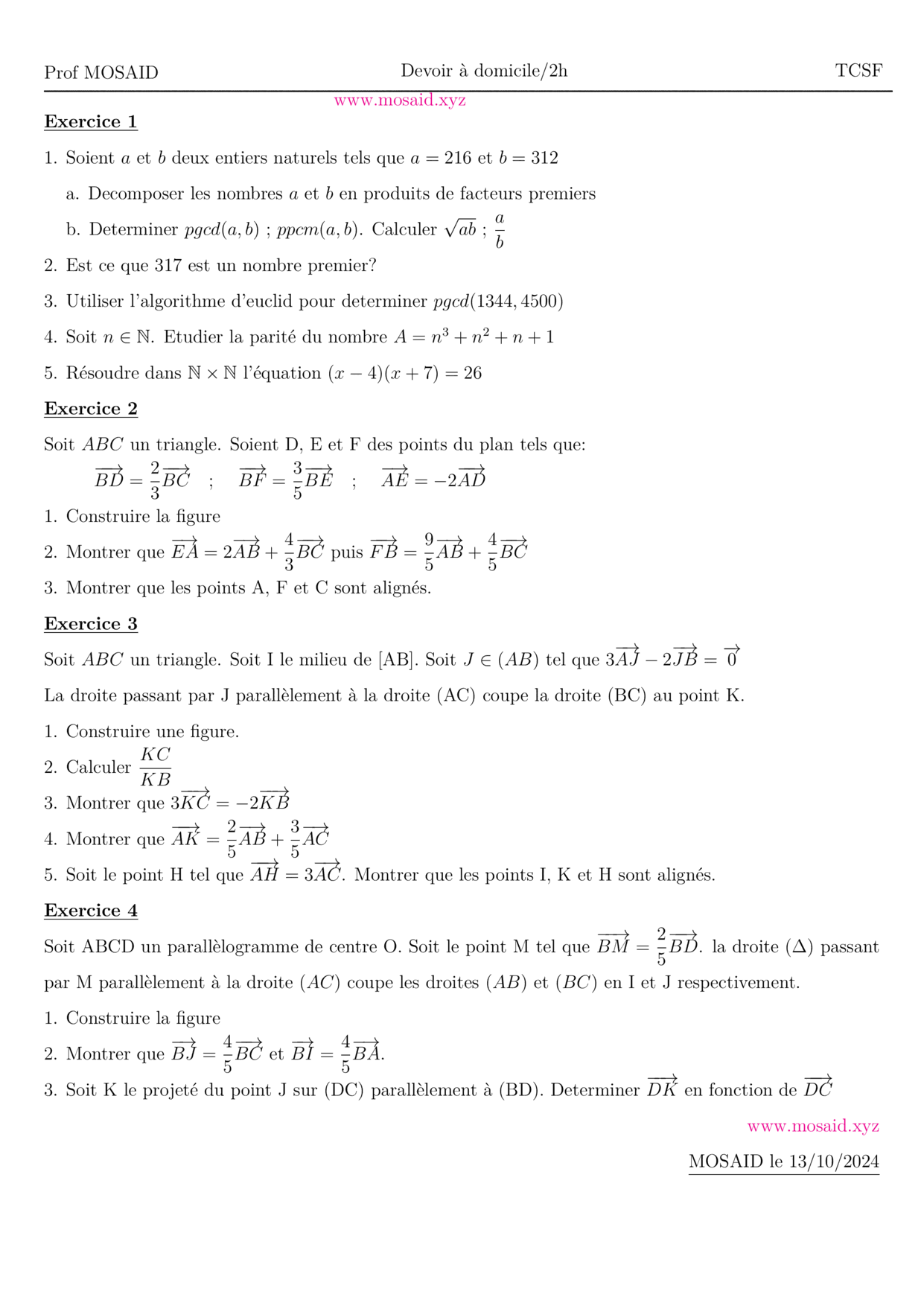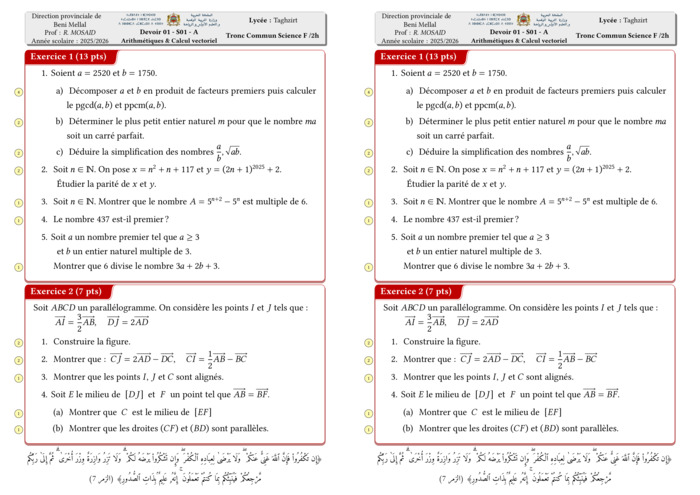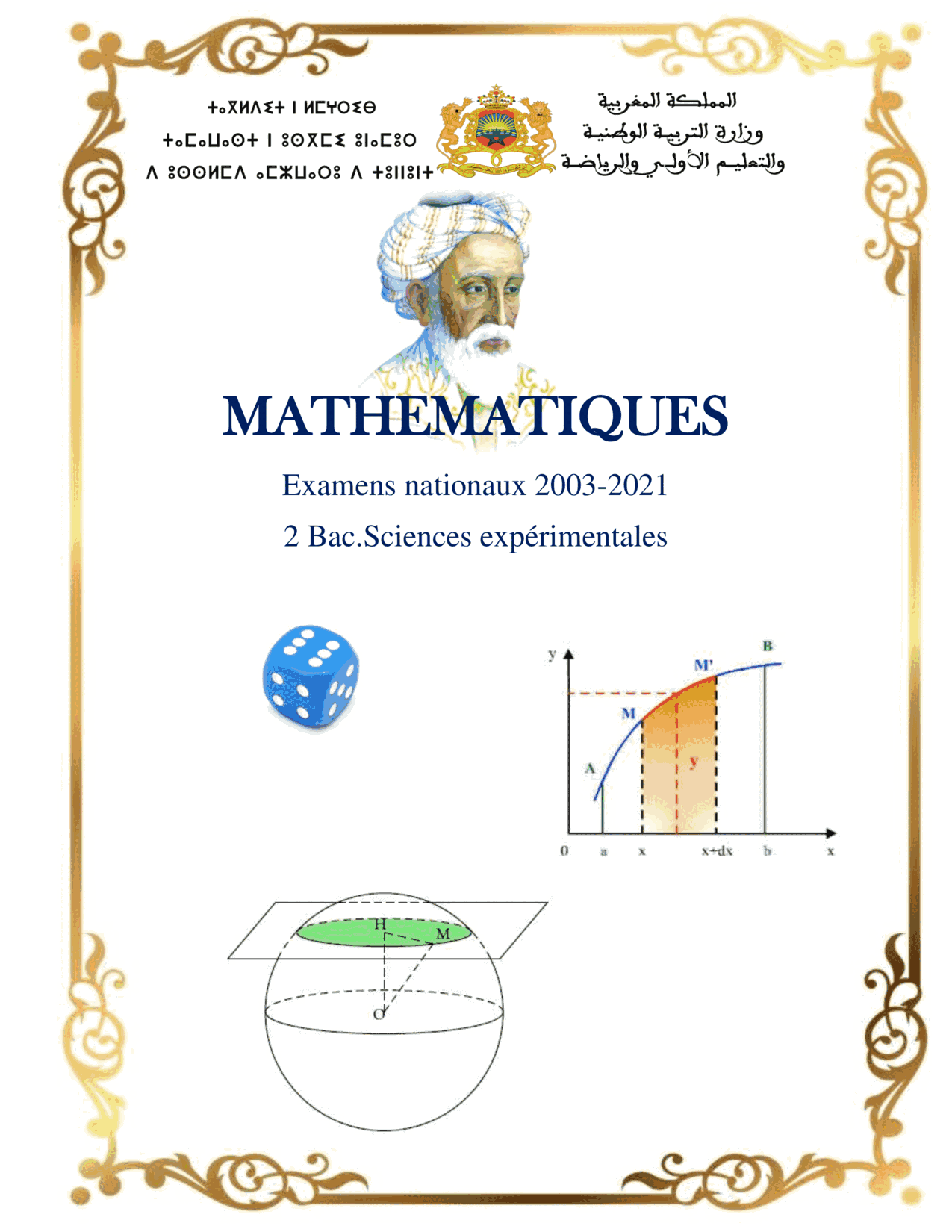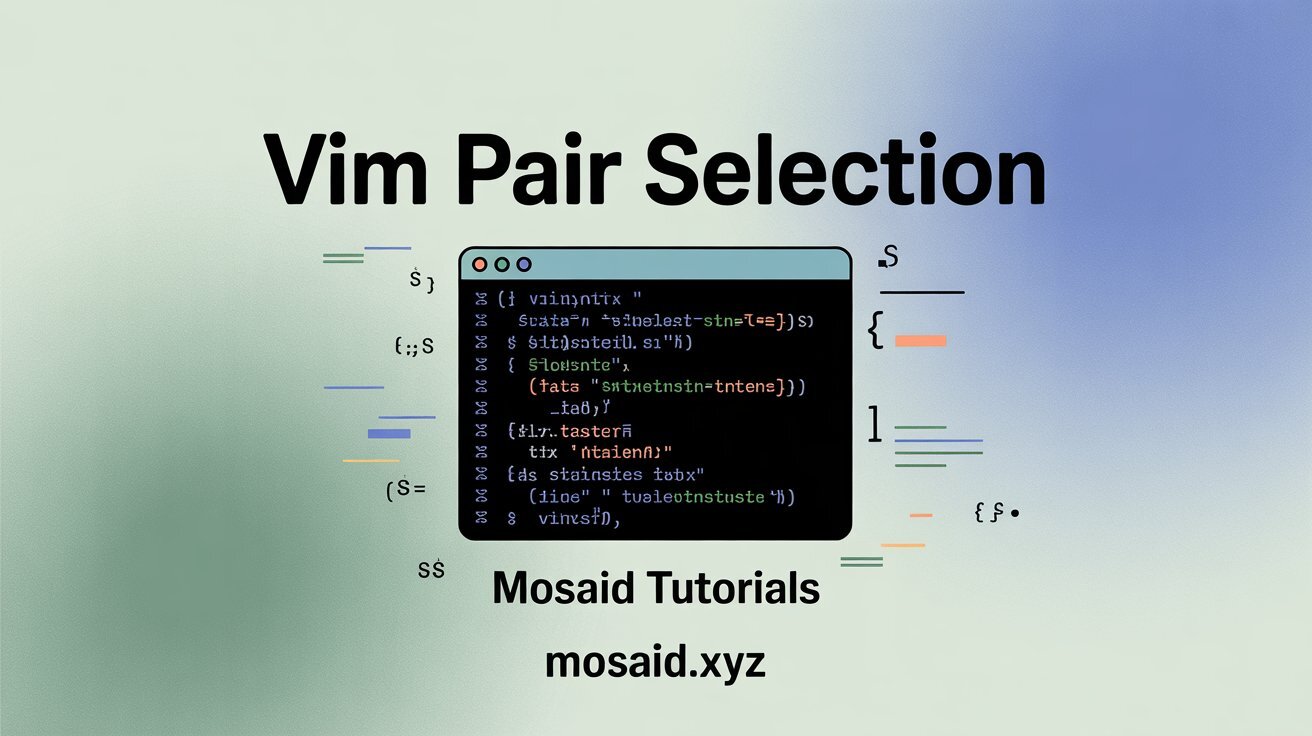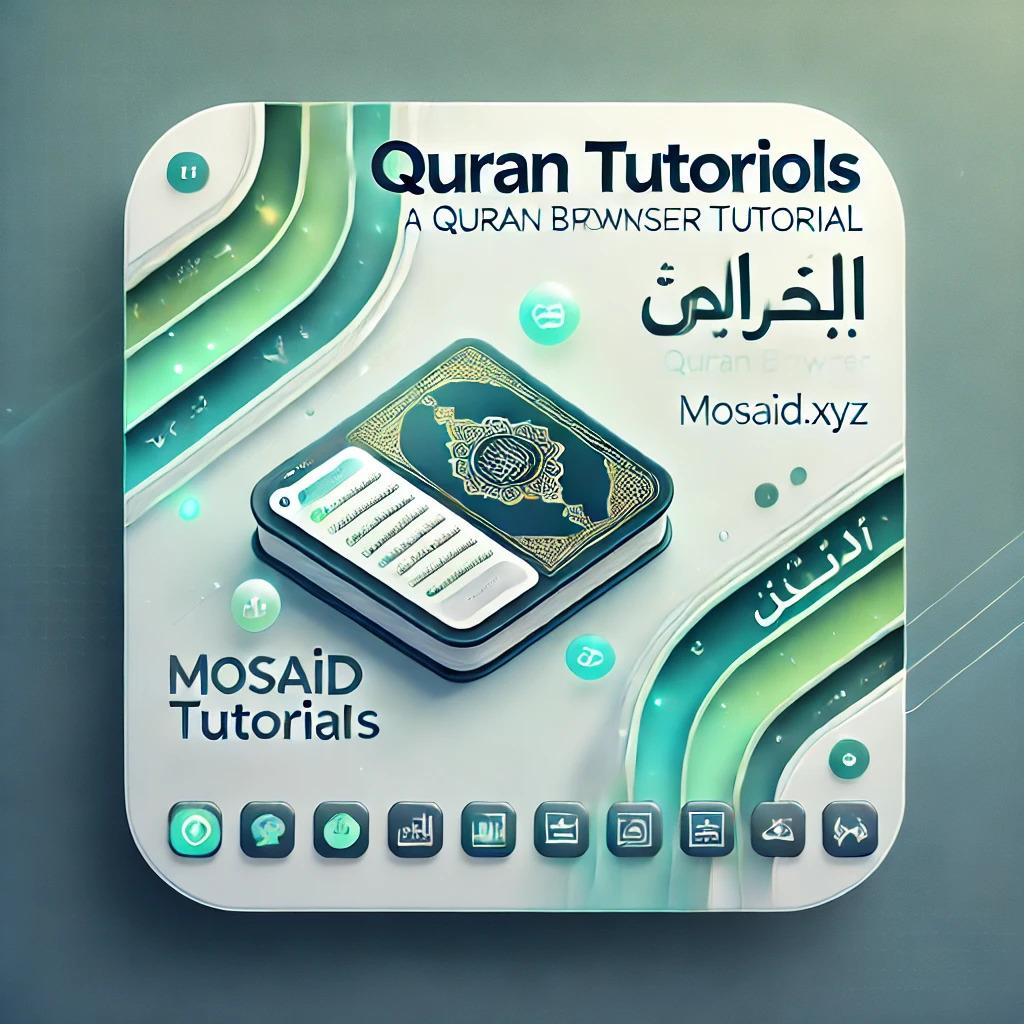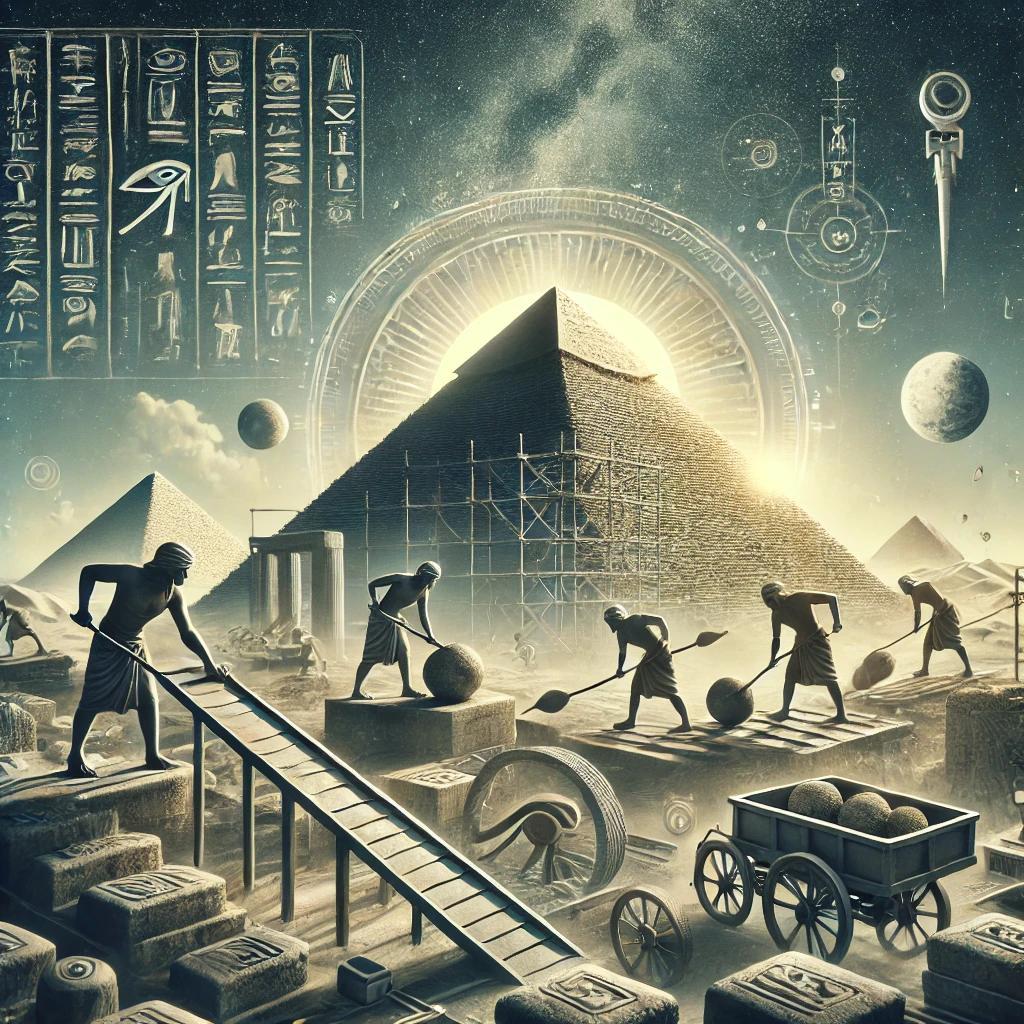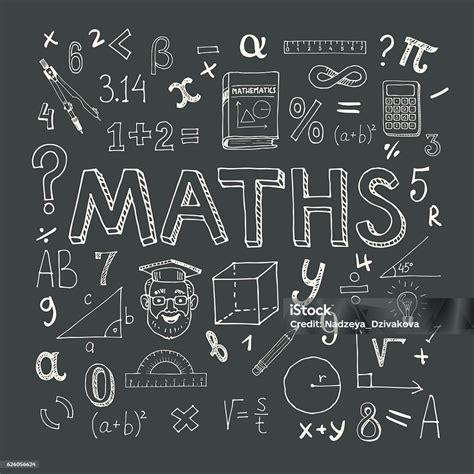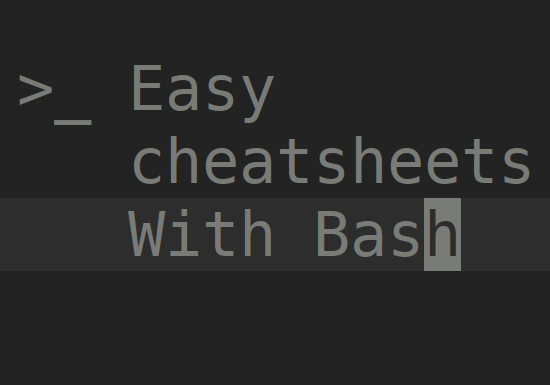Correction Control 1 (C) : Artithmetiques, Calcul vectoriel et projection
📅 November 01, 2024 | 👁️ Views: 245
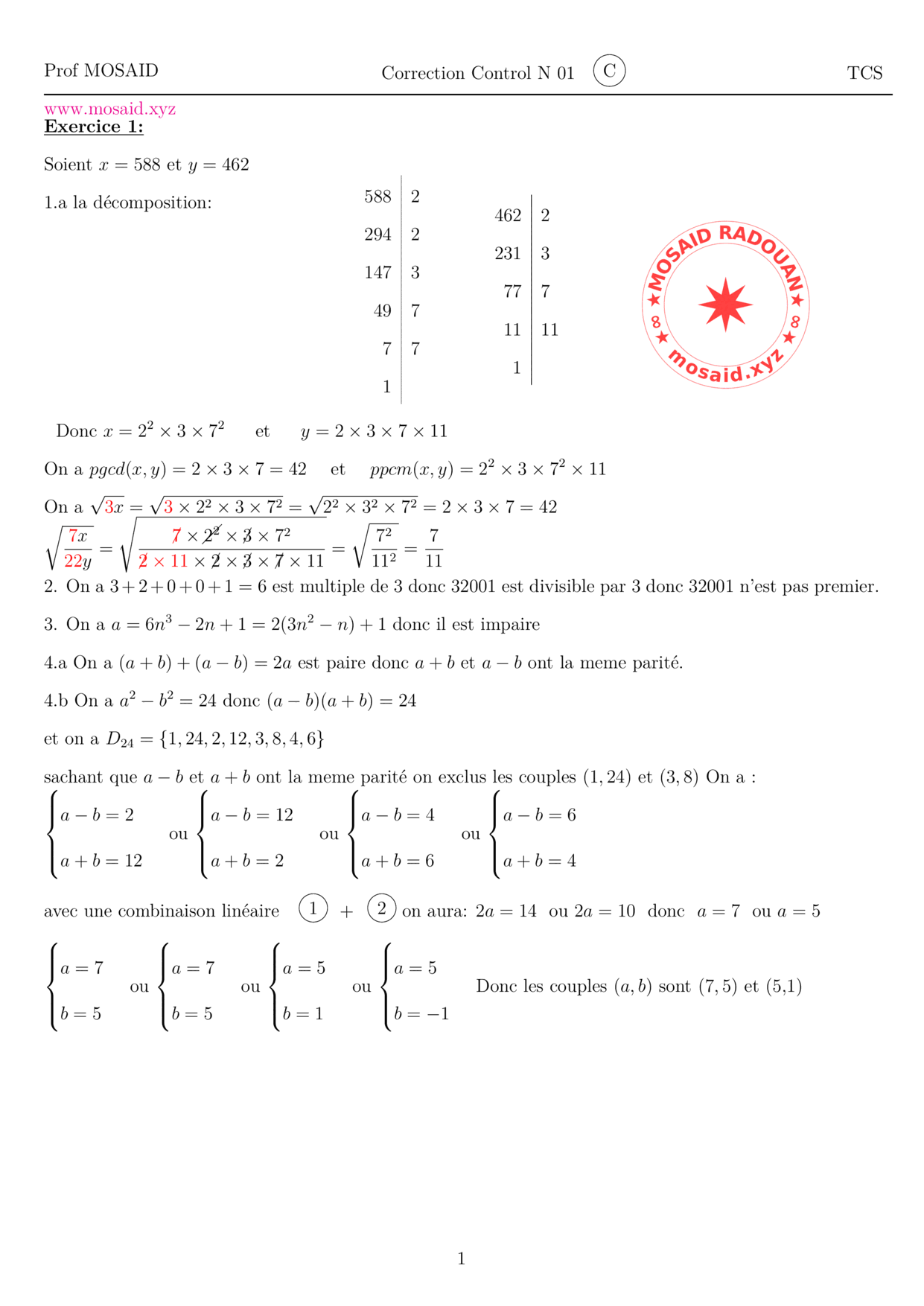
\documentclass[12pt,a4paper]{article}
\usepackage{tabularx}
\usepackage{booktabs}
\usepackage{ragged2e}
\usepackage[left=1.00cm, right=1.00cm, top=0.50cm, bottom=2cm]{geometry}
\usepackage{amsmath,amsfonts,amssymb}
\usepackage{cancel}
\usepackage{fontspec}
\usepackage{mathrsfs}
\usepackage{setspace}
\usepackage{multirow,multicol}
\usepackage{xcolor}
\usepackage[ddmmyyyy]{datetime}
\usepackage{tikz,tkz-tab}
\usetikzlibrary{shapes,decorations.text,intersections,calc}
\usepackage{hyperref}
\setstretch{1.7}
\setlength{\columnsep}{0.4cm} % Adjust space between columns
\setlength{\columnseprule}{0.4pt} % Width of the vertical line
\hypersetup{
colorlinks=true,
linkcolor=blue
}
\newcommand{\mylink}{\href{https://mosaid.xyz/cc}{www.mosaid.xyz}}
\newcommand{\ccc}[1]{
\begin{tikzpicture}[overlay, remember picture]
\node[circle, inner sep=3pt, draw=black, outer sep=0pt] at (0.5,0.2) {#1};
\end{tikzpicture}
}
\newcommand{\stamp}[2]{
\begin{tikzpicture}[remember picture, overlay]
\coordinate (A) at (#1,#2);
\draw[red!50] (A) circle (1.9cm);
% Draw the inner circle
\draw[red!50] (A) circle (1.4cm);
% Draw the curved line
\draw[red!50, decorate, decoration={text along path,
text={|\fontspec{DejaVu Sans}\color{red!75}\bfseries|★MOSAID RADOUAN★},
text align={align=center}, raise=-3pt}] (A) ++ (180:1.6cm) arc (180:0:1.6cm);
\draw[decorate, decoration={text along path,
text={|\fontspec{DejaVu Sans}\color{red!75}\bfseries|∞★~mosaid.xyz~★∞ },
text align={align=center}, raise=-6.5pt}] (A) ++ (180:1.53cm) arc (-180:0:1.53cm);
\node[red!75,font=\fontsize{48}{48}\fontspec{DejaVu Sans}\bfseries\selectfont] at (A) {✷};
\end{tikzpicture}
}
\everymath{\displaystyle}
\begin{document}
\noindent
\begin{center}
\begin{tabular}{@{}p{0.22\textwidth}p{0.57\textwidth}p{0.17\textwidth}}
%\toprule
\multirow{2}{*}{\parbox{\linewidth}{Prof MOSAID \newline \mylink }}
& \Centering {Correction Control N 01 \ccc{C}} & \hfill TCS \\
\bottomrule
\end{tabular}
\end{center}
\noindent
\textbf{\underline{Exercice 1:}}\\
\noindent
Soient $x=588$ et $y=462$\\
1.a la décomposition:\\
\vspace*{-2cm}
\begin{center}
\begin{tabular}{r|l}
588&2\\
294&2\\
147&3\\
49&7\\
7&7\\
1&\\
\end{tabular}
\hspace*{1cm}
\begin{tabular}{r|l}
462&2\\
231&3\\
77&7\\
11&11\\
1&\\
\end{tabular}
\end{center}
\stamp{15.5}{3}
Donc $x=2^2 \times 3 \times 7^2$ ~~~~et~~~~ $y=2 \times 3 \times 7 \times 11$\\
On a $pgcd(x,y)=2 \times 3 \times 7 = 42$ ~~~et~~~ $ppcm(x,y)=2^2 \times 3 \times 7^2 \times 11$\\
On a $\sqrt{\textcolor{red}{3}x}=\sqrt{\textcolor{red}{3}\times 2^2 \times 3 \times 7^2}=
\sqrt{2^2\times 3^2 \times 7^2}=2 \times 3 \times 7 = 42$\\
$\sqrt{\frac{\textcolor{red}{7}x}{\textcolor{red}{22}y}}=
\sqrt{\frac{\textcolor{red}{\cancel{7}} \times \cancel{2^2} \times \cancel{3} \times 7^2}{\textcolor{red}{\cancel{2} \times 11} \times\cancel{2} \times \cancel{3} \times \cancel{7} \times 11 }}=
\sqrt{\frac{7^2}{11^2}} = \frac{7}{11}$\\
2. On a $3+2+0+0+1=6$ est multiple de 3 donc 32001 est divisible par 3 donc 32001 n'est pas premier.\\
3. On a $a=6n^3-2n+1=2(3n^2-n)+1$ donc il est impaire\\
4.a On a $(a+b) +(a-b)=2a$ est paire donc $a+b$ et $a-b$ ont la meme parité.\\
4.b On a $a^2-b^2=24$ donc $(a-b)(a+b)=24$\\
et on a $D_{24}=\{1,24,2,12,3,8,4,6\}$\\
sachant que $a-b$ et $a+b$ ont la meme parité on exclus les couples $(1,24)$ et $(3,8)$ On a :\\
$
\begin{cases}
a-b=2\\
a+b=12
\end{cases}
$
ou
$
\begin{cases}
a-b=12\\
a+b=2
\end{cases}
$
ou
$
\begin{cases}
a-b=4\\
a+b=6
\end{cases}
$
ou
$
\begin{cases}
a-b=6\\
a+b=4
\end{cases}
$
\\[0.5cm]
avec une combinaison linéaire \ccc{1} ~~~~~ $+$\ccc{2} ~~~~ on aura: $2a=14$ ~ou~$2a=10$ ~donc~ $a=7$ ~ou~$a=5$ \\[0.5cm]
$
\begin{cases}
a=7\\
b=5
\end{cases}
$
ou
$
\begin{cases}
a=7\\
b=5
\end{cases}
$
ou
$
\begin{cases}
a=5\\
b=1
\end{cases}
$
ou
$
\begin{cases}
a=5\\
b=-1
\end{cases}
$
Donc les couples $(a,b)$ sont $(7,5)$ et (5,1)\\
\clearpage
\noindent
\textbf{\underline{Exercice 2:}}\\
1. La figure:\\
%\hspace*{7cm}
\begin{tikzpicture}[]%remember picture, overlay
\coordinate (A) at (2,5);
\coordinate (B) at (6,5);
\coordinate (C) at (3,2);
\coordinate (D) at (-1,2);
\coordinate (E) at ($(B)!0.333!(C)$);
\coordinate (F) at ($(D)!0.333!(C)$);
\coordinate[label=above right:$M$] (M) at (intersection of A--E and D--C);
\coordinate[label=above left:$N$] (N) at (intersection of A--F and B--C);
\draw (A) -- (B) -- (C) -- (D) -- cycle;
\draw[->,thick,red] (B) -- (E);
\draw[->,thick,red] (D) -- (F);
\draw[->,thick,blue] (A) -- (M);
\draw[->,thick,blue] (A) -- (N);
\draw[thick,dashed] (C) -- ($(C)!1.1!(M)$);
\draw[thick,dashed] (C) -- ($(C)!1.1!(N)$);
\draw ($(E)!1.2!(A)$) -- ($(E)!1.2!(M)$) ;
\draw ($(F)!1.2!(A)$) -- ($(F)!1.1!(N)$) ;
\node[above left] at (A) {A};
\node[above right] at (B) {B};
\node[below right] at (C) {C};
\node[below left] at (D) {D};
\node[above left] at (E) {E};
\node[above right] at (F) {F};
\end{tikzpicture}\\
\stamp{11}{3}\\
2. Montrer que $\overrightarrow{AE}=\frac{1}{3}\overrightarrow{AM}$:\\
dans le triangle EMC. on a $B\in (EC)$ et $A\in (EM)$ tels que $(AB)//(CM)$ car $(AB)//(CD)$\\
D'aprés le theorème de thales On a $\frac{BE}{BC}=\frac{AE}{AM}$ avec $\frac{BE}{BC}=\frac{1}{3}$\\
donc $\frac{AE}{AM}=\frac{1}{3}$ alors $AE=\frac{1}{3}AM$ et puisqe le sens $A \rightarrow E$ est le meme
que $A \rightarrow M$ et les points sont alignés alors $\overrightarrow{AE}=\frac{1}{3}\overrightarrow{AM}$\\
2. Montrer que $\overrightarrow{AF}=\frac{1}{3}\overrightarrow{AN}$:\\
dans le triangle FNC. on a $D\in (FC)$ et $A\in (FN)$ tels que $(AD)//(CN)$ car $(AD)//(BC)$\\
D'aprés le theorème de thales On a $\frac{DF}{DC}=\frac{AF}{AN}$ avec $\frac{DF}{DC}=\frac{1}{3}$\\
donc $\frac{AF}{AN}=\frac{1}{3}$ alors $AF=\frac{1}{3}AN$ et puisqe le sens $A \rightarrow F$ est le meme
que $A \rightarrow N$ et les points sont alignés alors $\overrightarrow{AF}=\frac{1}{3}\overrightarrow{AN}$\\
3. On a \\
$\overrightarrow{AE}=\frac{1}{3}\overrightarrow{AM}$~~~
$\overrightarrow{AF}=\frac{1}{3}\overrightarrow{AN}$~~~
donc $\overrightarrow{AE}-\overrightarrow{AF}=\frac{1}{3}\overrightarrow{AM}-\frac{1}{3}\overrightarrow{AN}$~~~
donc $\overrightarrow{FA}+\overrightarrow{AE}=\frac{1}{3}(\overrightarrow{NA}+\overrightarrow{AM})$\\
alors $\overrightarrow{FE}=\frac{1}{3}\overrightarrow{NM}$\\
alors $(EF)//(MN)$\\
\textcolor{white}{.}\hfill \underline{MOSAID le \today}\\
\vspace*{-1cm}
\textcolor{white}{.}\hfill \mylink
\end{document}
Related Courses, Exams, and Exercises
Solution PDF:
📥 Download Correction Control 1 (C) : Artithmetiques, Calcul vectoriel et projection (PDF)
if you find this content helpful, Please consider supporting me with a small donation
إن وجدت هذا المحتوى مفيدا، من فضلك إدعمني بمبلغ بسيط كتبرع
Buy me a coffee — إشتر لي قهوة
PayPal.me • عبر بايبالOr bank transfer • أو حوالة بنكية
Titulaire : RADOUAN MOSAID RIB : 230 090 6501953211022000 65 IBAN : MA64 2300 9065 0195 3211 0220 0065 BIC / SWIFT : CIHMMAMC
